#frank rosaly
Explore tagged Tumblr posts
Text
youtube
Here's Bolivian-born singer and multimedia performer Ibelisse Guardia Ferragutti and Chicago expat jazz drummer Frank Rosaly's "DESTEJER," from MESTIZX, their debut full-length album as co-composers, arrangers, and musicians, due May 3 on International Anthem / Nonesuch Records. The video was filmed near Ferragutti’s hometown in Cochabamba, Bolivia, by director Espectador Domesticado.
#ibelisse guardia ferragutti#frank rosaly#destejer#mestizx#bolivia#jazz#international anthem#nonesuch#nonesuch records#Youtube
2 notes
·
View notes
Text
Dave Rempis Percussion Quartet — Harvesters (Aerophonic)

Harvesters by Rempis Percussion Quartet
Saxophonist Dave Rempis is joined on Harvesters by bassist Ingebrigt Håker Flaten and two drummers, Tim Daisy and Frank Rosaly. The group last recorded in 2013, and the double CD is from their first tour of France in March 2023, a live evening at Le Petit Faucheux in Tours (The English translation of the venue’s name is “Little Daddy Long Legs”—Harvester is another name for the spider). Rempis and company spent a week visiting five venues in France. The set from Tours, their first night in the country, is extraordinary music-making.
Two pieces are on the first CD. “Everything Happens to You” is a half-hour long piece that presents an interesting reversal. It begins with trills and shrieks, out of which, after considerable free improv, a tune emerges. This setup is the opposite of traditional jazz performances, where the tune begins the proceedings to be followed by solos. The drummers create a welter of polyrhythms, rather than interlocking, complementing and responding to each other. Listening again, one can find scraps of the melody that eventually appears: Crafty construction and passionate execution.
Trumpeter Jean-Luc Cappozzo guests on “The Exuberant Aubergine,” playing high, breathy, glissandos while Rempis once again plays fleet trills. It is a slow tempo piece that is also a slow burner. The percussionists, for the most part, keep their powder and the dynamic level low. Cappozzo unfurls a wide-ranging solo and Rempis responds with bent notes and high glissandos of his own. Håker Flaten contextualizes the harmony with scalar passages and chromatic passagework. Cappozzo and Rempis trade riffs, sometimes imitating one another and at others doing their own thing. Duet becomes a trio with bass notes double-timing, moving through all the registers of the instrument. Solos are exchanged in the next section, with the percussionists pressing the action with muscular playing. Midway through, the surface calms, bass notes repeated instead of the previous scalar movement, misterioso melodies from trumpet and saxophone, and a general slowing down. Pops, clicks and slurps from the winds are responded to by accentuations in the percussion. A gradual accelerando and the return of Rempis’ trills signal a return to the demeanor of the opening volleys. The intensity ratchets up, with the drummers becoming more prominent than the winds, despite their altissimo held notes. Once again, riffs are traded, with a call and response between Rempis and Cappozzo responded to by intense playing from the rhythm section. The conclusion sees the drums move back to a simmer, the bass playing repeated notes against a decrescendo by the winds. Exuberant indeed.
CD 2 chronicles the second set. “Spooky Action” begins with a drum duet that introduces a syncopated rhythmic pattern. Rempis is buoyed by the drumming to soaring solos. Håker Flaten adds yet another layer of metric ambiguity. The rhythm section maintains its energetic performance, Rempis exploring and melding various melodic cells of material, creating flurries of ostinatos. Once again, a soulful melody is saved for late in the piece. At the last, the drums drop out, the bass plays repeated pitches, and Rempis builds the repeating patterns into a caterwauling climax, with the percussionists only then edging back in. Rempis concludes with a bluesy cadenza, punctuated by aphoristic gestures from the other players.
“Little Fascists” begins with Cagean percussion improv. Rempis enters similarly, with disjunct riffs and rasping, sustained pitches. He then builds overtones with perfectly tuned harmonics. Håker Flaten contributes a long high register arco trill, adding to the sense of experimentation. Rempis adds keening wails at the end of the piece. While the free jazz blowing on other tunes is exciting, “Little Fascists” has a distinctive sound world that is fascinating.
The final tune, “Fat Lip” opens with a bass solo in which harmonics are juxtaposed against a pizzicato solo that ranges the whole instrument. Håker Flaten has been a keen collaborator throughout the concert, and his solo brings this style to the fore. Rempis joins him with an undulating melody that begins brawny and slow and proceeds to mercurial runs. The drummers alternate between pulsation and freely constructed fills. Rempis returns to his mid-register melody, embellished with quick scales. The saxophonist savors an intervallic sequence, tweaking it here and there with half step variations. His solo quickens and takes up a stentorian tone. The rest of the group recognizes his intentions, pressing forward and creating a sweltering density. With raucous howls and undulating lines, Rempis fragments “Fat Lip’s” melodic contours. He eventually settles on two short riffs, that he repeats as the drummers add still more fills and Håker Flaten plays a modal ostinato. The conclusion is a decrescendo with a sizzle of cymbal at the end.
One hopes that more of the France tour might be committed to disc. This is Aerophonic’s tenth anniversary, and there are few better ways to celebrate than more of Rempis’s Percussion Quartet.
Christian Carey
#dave rempis percussion quartet#harvesters#aerophonic#christian carey#albumreview#dusted magazine#dave rempis#Ingebrigt Håker Flaten#tim daisy#frank rosaly#jazz#Jean-Luc Cappozzo
5 notes
·
View notes
Text
Europe Jazz Media Chart - Lipiec 2024
Wybór nowości muzycznych, dokonany przez grupę czołowych europejskich magazynów i witryn jazzowych. A selection of the hot new music surfacing across the continent by the top European jazz magazines and websites. RGG / Pauli Lyytinen / Samuel Blaser City of Gardens vol.2 (VoiceMusic) Krzysztof Komorek, Donos kulturalny, Polska Tomasz Stanko Quartet September Night (ECM) Dick Hovenga, Written…

View On WordPress
#ACT Music#Andy Moor#artistShare#Arve Henriksen#Barry Guy#Circum-Disc#Clean Feed Records#Double Moon Records#ECM#EJN Media Chart#Erik Friedlander#Estonian Voices#Fes#Frank Rosaly#Fun in the Church#Guiseppe Doronzo#Hans Lüdemann#Harmen Fraanje#Hypnote Records#Iiro Rantala#Iiro Rantala Hel Trio#Ivann Cruz#Jérémie Ternoy#Jersika Records#Jon Gordon#Jordina Millà#Kathrine Windfeld#Kuba#Marco Martins#Marco Martins Quintet
0 notes
Text
Ibelisse Guardia Ferragutti & Frank Rosaly Interview: Knowledge and Dignity
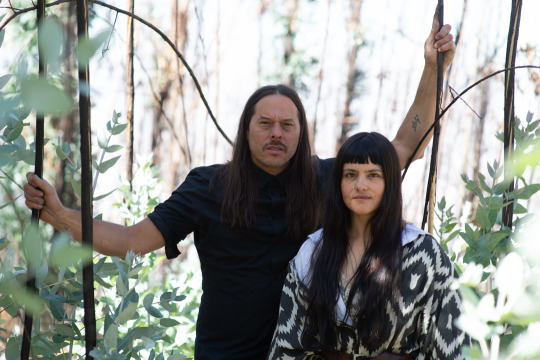
Photo by GUMO
BY JORDAN MAINZER
When I log on Zoom to interview creative and life partners Ibelisse Guardia Ferragutti and Frank Rosaly, I expect to see them together. Instead, Ferragutti's at their home in Amsterdam, and Rosaly's camera is set up somewhere outside, but he's not there at all. (The Zoom active speaker view keeps on highlighting him because birds are chirping.) As I introduce myself to Ferragutti, Rosaly eventually shows up, and they explain to me that he's at a house in the forest they share with friends. The contrast between the two locations--personal and internal, earthbound and communal--fittingly mirrors the dichotomy of what I'm there to ask them about, the stunning MESTIZX (International Anthem/Nonesuch). Ferragutti and Rosaly's new album represents the first time either artist publicly confronted aspects of their Latin heritage. It's also their first record at all. Even Rosaly, the prolific experimental music drummer who has played with everyone from indie rock lore like Thurston Moore and Ryley Walker to jazz stalwarts such as Dave Rempis and Matana Roberts, has never made anything that sounds quite like MESTIZX, and only ¡Todos de Pie!, his project exploring the music of Puerto Rico through improvisation, came close to touching the record's layered themes. Nonetheless, Ferragutti and Rosaly have managed to dive deep into complexities while finding a collaborative artistic voice.
The word "mestizx" is a non-gendered word of "mestizo" or "mestiza", the Spanish colonial term for mixed race, an identity the duo owns and turns upside down with MESTIZX. Ferragutti was born in Bolivia and is of Bolivian and Brazilian heritage, countries colonized by Spain and Portugal, respectively. The majority of the modern Bolivian population identifies as "mestizo," a mix of Indigenous and European heritage, of the colonizer and the colonized. It's this in-betweenness that Ferragutti wished to dissect on MESTIZX, a feeling beyond simply growing up with the music of the Bolivian and Brazilian diaspora. Rosaly, meanwhile, is of Puerto Rican heritage but wasn't allowed to speak Spanish outside of his home during childhood, as his parents wished to assimilate him as much as possible to the English-speaking United States. Before he became the dynamic, noisy drummer he was today, he fell in love with percussion and first connected with his roots when watching another drummer of Puerto Rican heritage perform, the late, great Tito Puente. The sounds on MESTIZX touch on all of these musical traditions and more, intensely reflective.

Photo by GUMO
Yet, Ferragutti and Rosaly's approach is also immaculately researched and respectful. Both artists went to school for music; though the songs on MESTIZX are anything but traditional, they reflect Ferragutti and Rosaly's deliberately academic exploration of music-making. They took the time to understand the ritualistic and cosmological context of each included instrument and rhythm before connecting it with modern-day ideas of decolonization and protest via Ferragutti's lyrics. That is, whether it's the impossibly wide array of percussion instruments from all over the world or Ferragutti's synthesizers effected to sound like pan flutes, everything on MESTIZX is included for a reason. "I didn't go thinking on this record, 'I want to use African instruments.'" Rosaly said. "When we were first starting to play around with instruments in the living room and hanging out, the mbira was around, and I came up with this little harmonic sequence, and things started landing on top of that instrument. I had to ask myself, 'I love the sound, of course, but am I using it for reasons that are dignified for the instrument and its lineage without appropriating?" Rosaly studied the way in which the African diaspora was embedded in Puerto Rico. "That musical and spiritual ideology traveled," he said. "Suddenly, the mbira had a place for me."
As much as MESTIZX sounds on paper like an ethnomusicologist's favorite new album--just take a look at the album's immersive liner notes--Ferragutti and Rosaly emphasized to me that the actual qualities of the songs are exemplary of the two's past musical influences and contemporary artistic community. Rosaly's history in the Chicago post-rock and jazz scene shines through, making a song like the album's title track, full of wiry guitars, an orchestra of synthesizers, and Ferragutti's captivating vocals, earn its pitched-to-me would-be-ridiculous descriptor of "Elza Soares fronting Hail To The Thief-era Radiohead." Moreover, on each song, the two solicited contributions from a who's who of contemporary experimental musicians, from bassist Matt Lux and cornetist Ben LaMar Gay to guitarist Bill MacKay and multi-instrumentalist Rob Frye. It's a testament to the collective's creativity how natural, often groovy, and cohesive the songs sound, despite each's long list of players, many of whom play multiple instruments per tune. On lead single "DESTEJER", Ferragutti differentiates between being intertwined with her roots and being suffocated by them, singing, translated from Spanish, "The present conjures the past that informs the future / I dodge the trap / I am not raw material." Her words form a push-pull with the clattering percussion, courtesy of Rosaly and Mikel Patrick Avery's tambourine and caxixi, and the woodwinds that alternate between flutters and smooth expressions, demonstrating the tension within.
Ultimately, the next step for Ferragutti and Rosaly is where the songs on MESTIZX go from here. Right now, they're exploring them in a live setting, on tour in Europe with Lux, Gay, multi-instrumentalist Ben Boye, and pianist Marta Warelis. Before embarking on tour, the two rehearsed simplified versions of the songs themselves, but just like the record, the songs will become fully fleshed only when the duo invites their friends on stage to help them along the way, participating in the modern-day ritual of playing music, a full circle return to the rituals Ferraguti and Rosaly studied to prepare to make the album. "The medium of the record is one thing, and songs need to be certain lengths for them to stay buoyant," Rosaly said. "Having a whole family of magical people we can tour with in different contexts, the music is going to open up in very unforeseen ways."
Below, read my conversation with Ferragutti and Rosaly, edited for length and clarity. We talk about MESTIZX, the album's art and videos, roots, colonialism, and Chicago post-rock.

Since I Left You: Reading about the ideas and story behind MESTIZX, it's clear the issues of identity it deals with are things the two of you have been grappling with for a long time. Why was right now the time you decided to sit down and make this album?
Ibelisse Guardia Ferragutti: In my case, it's been something I've been dealing with my whole life. I've felt a super loud presence of my roots and realized not everybody where I come from had that. It was almost a burden, a curse. [laughs] But also totally not and really beautiful. It had a big influence in a good way and sometimes in not such a nice way, to the point I had to do something with it. I didn't know exactly what ["it"] was, so I let it go, but the moment I really faced ["it"] through music, I allowed for a lot of healing in terms of my relationship to my roots, the painful parts of my roots, and the beautiful parts of my roots. I also [have] a lot of connection with people, rhythms, and the pain of what it is to come from places so deeply colonized.
I just read an article that somebody wrote in Germany [about MESTIZX], and they called it a bit of a self-help record. [laughs] I don't know, I think it's more than that for me. It's not just about me. It's about something we share as a collective intelligence, where we're at in this moment, in the South American diaspora.
Frank Rosaly: [Self-help] sounds like a bit of a simplification of the context of the record. I started thinking about this stuff around 2006. I had a pretty disconnected relationship with Puerto Rico, by design. My parents kept me as integrated as possible to my benefit. I don't necessarily identify as being Puerto Rican outright. When Ibelisse and I met and began our partnership, being in partnership with a Latina really opened a dialog that was never really so open in my life. That's when things really shifted into high gear in dealing with some of the themes you hear about on this record.
SILY: What about during the process of writing or recording or playing with others? Did your relationship to your roots change?
FR: For me, it deepened things. Since Ibelisse is the guardian of the lyrics, and I'm oversimplifying things here, but I'm creating content from the musical side of things--we're both doing that of course--the rhythms that come from certain regions and all of my research, studies, and interest in that material had a place. Before that, playing with Ryley Walker, it didn't make sense to throw some bomba in there. All of a sudden, this incredible amount of something from within became dislodged and able to move through me and the music, that I hadn't given a lot of space for. I've only been in one project that I created myself, ¡Todos de Pie!, that began to talk about this and research this a bit. This project really set it all free, and it became a waterfall.
IGF: For me, I think it was a really beautiful and intense process, to confront my own biases. I studied classical piano, have done a lot of punk music, and realized in my education, by default, even growing up in South America, I wasn't in contact with the music of the territory, with the real roots. The process of this music was so deep that I started talking with a lot of people and doing a lot of research about how much by design you are already given this very Western idea of listening to, making, and belonging to music. I felt so sad that in my country, we never had enough power to appreciate what we already had there. It's stunning, the most beautiful drum music I've ever heard. It sounds self-helpy, but it's not: It was a big healing process of reconnecting with deeper layers of instruments that belong to a territory. Pan flute, I just see it in the main squares, people playing it in the street, but it's actually a very powerful instrument when put in its right context for its right ritual and purpose. For me, it was a really big journey to go really deep and really dare to listen to things I couldn't listen to before. Even if I don't use the pan flutes, to have a reverence for where my ancestors come from and have a space to listen. The magic embedded in those rituals is out of this world. It's like they're people from the stars. I can't explain the whole thing--it's like a whole book--but I was so stunned by the cosmologies of the people from those territories. This record brought me there, and I'm very, very thankful for that.
SILY: Your average music listener might not think about the fact that an instrument, rhythm, or sound can have its own proper sociohistorical context independent of the sheer quality of how it sounds. Were you hoping to further educate listeners with this record?
FR: I wouldn't go as far as to say "educate." At the end of "BARRO", there's panderetas being played, and it's not some sort of reference or a shoutout, as in, "Here's a little Puerto Rican tidbit." It really has a place in the song because of what the song is talking about and what we're trying to invoke. I found it imperative; there's an urgency for that to happen. When we started making the record, we weren't trying to make a Latin-feeling record--we both tend to make pretty noisy, experimental stuff--but because of the content of the record and what's really happening inside of the music, it informed us to make a different decision as to how the music can be carried by song, flow from song to song, to make a record and an entire story. I've never thought this deeply about all the connective tissue and the meaning of everything on this record. Nothing is put in place, like, "A shaker would be nice!" A shaker is there because it really needs to be there, not just on a musical level, but because of the message.
IGF: I feel like I am a bit more educated; I'm going to start by educating myself. I can communicate to other people. I don't feel like I'm allowed to play a pan flute or anything like that. I know much more now than what I knew before, but that knowledge and dignity I felt making the record is embedded in the music by default, by the way I talk about things, choose this word or that sound. It has to do with a repercussion of understanding the dignity of those instruments in the territories they are made and played: agricultural reasons, cosmological reasons. That knowledge is so inspiring, it helped me decide how to make this record. The record is a reflection of what I learned.
SILY: What determined what language each song was in?
IGF: I think it had to do with the sound. We built "MESTIZX" like a singer-songwriter [song,] and it just came out in Spanish, naturally. Some songs started from the lyrics towards the instrument, others from the drums towards words. At a certain point--and with the help of Frank--I was listening so openly, the song would tell you what language it needed to be sung in. “SABER DO MAR”, the second song of side B, is often translated in the reviews as "Know the Sea", but it's actually "The Knowledge of the Sea". I was thinking that all of these people came from the Africas to Brazil and informed so much music and brought their instruments, gods, and belief systems. I was really inspired by the language carried in that diaspora between Africa and Brazil, which is the colonizer language, which is Portuguese. The sea brought all of these languages to Brazil, and to Bolivia. The last two [songs] in English...I think it has something to do with this "mestizx" thing. I communicate nowadays in English rather than in Spanish or Portuguese. I didn't grow up with it, but I use it so much it's embedded in how I think, how I feel, how I communicate with my love, Frankie. We just communicate in English. Frankie doesn't understand Spanish or Portuguese, so English is our bridge. English is a powerful medium for this record, in terms of all of the voices that live within us.

Photo by Saskia Ludden
SILY: Frank, in terms of music where you come from, how would you say Chicago post-rock informed this record?
FR: I would argue that the fabric of how I think about playing is woven almost strictly from my experiences in Chicago and the music that brought me there in the first place, which dislodged me from a weird path of institutional jazz learning and going to school. I heard Sam Prekop's first solo record with Chad Taylor and Joshua Abrams, then I heard Isotope 217, then Tortoise. I was in Arizona at the time, then I moved to L.A. for a while. I was really in a bubble before that. Suddenly, everything changed because of that sound. It's not any particular artist. They've all influenced me in so many ways. Not necessarily, "I'm going to play like Dan Bitney now because I love that sound," but the principal of how Dan Bitney fits in Tortoise, and how John Herndon sounds in Isotope, and the melodies that Rob Mazurek makes. [Mazurek] plays a lot of intervals in 4ths, which I fell in love with when I was in college composing, but then I was exposed to it in a new context which made me crazy. You hear 4ths everywhere in this record, which is because of Charles Ives by way of Rob Mazurek by way of Gastr del Sol and the free jazz and improvisational lineage from Chicago, from the Art Ensemble of Chicago to what's happening even now. It's all in there.
SILY: From a broad perspective, there seems to be a contrast in textures and moods in every song. Was that a goal, to have tactile instrumentation going on at the same time as something broad and expansive?
IGF: From my point of view, I don't know if it was a strategy as much as my listening inside the moment, which is of course a strategy. [laughs] For me, playing with synthesizers is a really nice way to speculate folkloric instruments. I would tune the synthesizer in different ways to make it have the same tuning as a pan flute. The electricity of the synthesizer had to be there because it's a medium that makes a lot of sense to tie the ancestral with the futuristic, to break through space and time. I was also thinking about whether I should sing or use words because [that way is] less post-rocky--I'm also super inspired by post-rock [laughs]--there was something bigger happening in terms of the palette of the sounds. My voice became a kind of instrument, so to say.
FR: I would argue another part of how I think about things has so much to do with that old version of myself when I was in school, learning about classical percussion and the percussion family. It's such an incredibly huge family of instruments that span across the world. They're all a part of my life, because I've studied them and they mean something to me. If I [use] a pandeiro from Brazil, it's not necessarily just because Ibelisse is speaking in Portuguese, or because it has anything to do with Brazil, but because it's the right sound.
SILY: Did you have specific people in mind you wanted to play on certain songs on the record?
FR: The first person we were thinking about was Matt Lux, because of his sound. I had worked with him on another project where he was the producer. The way he thinks about sound and very gently produces--he just says a few things and lets it sink in--he has a way of being very subtle about helping artists like Ibelisse and I move deeper into the music. We just wanted him around and then said, "Dude, you gotta bring your bass and play a little bit." He had always joked about being in retirement. Luckily, that's not the case. The last time I was in Chicago, I was supposed to do a recording session with Rob Frye and Ben LaMar Gay, and I got really ill. I really love their sound, [so I asked them]. Bill MacKay, I love that guy so much, he's been such a huge inspiration as a human being, let alone a musician, so we wanted to see whether he could arrive and play a few notes.
IGF: We also had some songs with guitar and thought his sound was really unbelievable. Avreeayl Ra is really amazing. Mikel Patrick Avery. There are so many.
SILY: Bill got to play requinto on "SABER DO MAR". I don't think I've heard him play that instrument on record since his album with Ryley Walker years ago.
FR: It's a beautiful sound. He really understood the depth of the music. He speaks Spanish and Portuguese really well.
IGF: We were at Into the Great Wide Open with Ryley, and Bill was there, and he started talking to me in Spanish and Portuguese!
FR: I would be remiss not to mention Chris Doyle, who lives in Amsterdam. He used to be in Antibalas and was in the scene in New York City, roommates with Jaimie Branch for a long time. We are dear friends and play in a few different projects together. He swooped in at the last minute and added some layers that only he could manage, because he's such an incredible musician and really subtle thinker. I would argue he's a producer in the way he added the tiniest touches of beauty that opened things up a little bit more, gave them more air, even though he was adding layers. Mikel Patrick Avery was visiting Amsterdam, and I just asked him to do a couple overdubs because of his feel and sound. He'll just take a toy tambourine and do something smooth as butter, even though that sounds corny.
IGF: There was a community aspect. [Avery] came to visit when we were at International Anthem, and we said, "Don't you want to play some congas or something?" [laughs] It worked out super well. The community aspect is similar to [that] where I come from.
FR: These are all people we're deeply in love with. We wanted that to be embedded in the music, that it's really coming from a place of love and sharing ideas together from a loving place.
SILY: Can you tell me about the history of the voice memo included on "BLESS THEE MUNDANE"?
IGF: Viktor [Le Givens]. [laughs]
RF: I didn't know him very well when I lived in Chicago, but there was a series that I ran at the Skylark in Pilsen for about 8 years with Nick Mazzarella and Anton Hatwich. It originally started with me and Jaimie Branch, but then she moved away. Viktor would come to some shows occasionally. I think he was going to Columbia at the time. He's been this character that orbits my consciousness often. Suddenly, I hear that Ibelisse is this festival in The Hague, and she sees this magical guy doing this thing with Angel Bat Dawid. I was like, "I know this guy!" I started following him on Instagram. This work he does is incredible. It's this beautiful archive of The Great Migration. It's stunning, the way he talks and thinks and presents. I kind of have a little bit of a man crush on him. I started sending him messages about his posts and watching his live feeds religiously for a while. We started exchanging voice messages, and I was telling him while Ibelisse and I were in the midst of making a record, we were busy with really small minor details, really mundane stuff, and he sent this message. It was like, "Uhh...right. Only Viktor could [take] something I was really struggling with and give it life and context." It was super inspiring for me, so I asked him if it was okay to use the voice memo for that conversation.
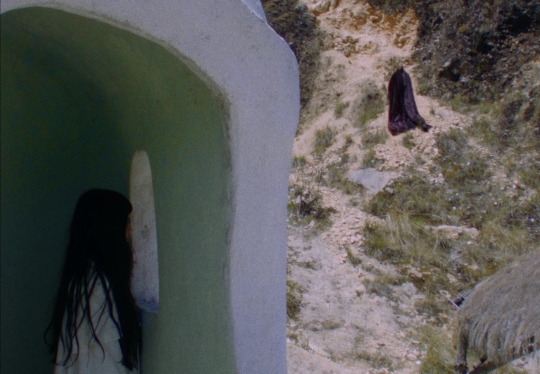
SILY: How involved were you in the visual identity of the record?
FR: The record cover, I kind of designed it.
IGF: [laughs]
FR: I didn't take the photo or anything like that, but I used Pages to design the [linework.] That came together pretty quickly based on something I drew up.
IGF: We were in Bolivia when we did [the album photos.] We wanted to have a couple amazing friends, photographers and visual artists--and I really wanted to have South American artists--involved in the images. A friend of mine took the pictures, and we went to a very beautiful mountain where I grew up, and to the market, these very crazy places in Bolivia. We did make a mood-board to guide our friend of how it could be, more or less. Not in all of the pictures, but in the cover picture, he really captured something we were longing for. It's full of the world around you, the territories that were talking to us so loudly. For the [video] for "DESTEJER", I asked someone in Bolivia who I didn't know but who I had been following for a while, [Espectador Domesticado]. The concept behind the concept, in Cochabamba, the lake, was, "How does the new generation perceive this music?" We talk all the time about ancestors and the past, but I also want to think about the future. These are ancestors of the future, 23 years old. So we did develop a little bit together, but I gave [the director] a lot of freedom to interpret the territory the way he wanted. We did help him with edits, but I left as much space as possible for his voice.
FR: For "TURBULÊNCIA", we were thinking, "We need to put out another single. Should we make a video? Should we?" Ibelisse and I are part of a collective called Molk Factory, and one of our collective members who is a wonderful video artist who works with projection and light, we asked her whether she wanted to make a video with us real quick. We added some ideas between all of us and came up with the idea of using very open space with movers and dancers. We wanted to deal with the dissonance of what the song is talking about. We wanted to tear apart or unweave, if I can use that word--
IGF: Destejer. [laughs]
FR: Destejer. We very quickly put the task at hand. "Let's mix this video." We filmed it in about 10-12 hours with the help of Marc Riordan, who used to live in Chicago. Incredible drummer, incredible pianist, and now he's really busy with a film living in L.A. He was visiting to play some shows with me and was the main camera operator, which is such a blessing because he's really good at thinking about cameras and how all of that works, because I have no idea. Within a 24-hour period of actual time, that video was formed. It was playful, immediate. We didn't think about too hard. It just came out. We were really happy with it.
IGF: The tricky part is it had digital post-production. When does digital [manipulation] become a response to what we were saying, not just a trick, but serve something more than a trick or a gimmick? It was a bit of a conversation with [director] Noralie [van den Eijnde], because it's called "TURBULÊNCIA", or "turbulence," with things out of control sometimes. How do we listen, and how do we use our hands to carve a new knowing together? Who is giving me the voice, and is that why the hands are moving my face? Is that the ancestors? This counterpoint between who is moving who: Is something moving the body, or is the body open enough to be losing its shape?
SILY: It's the colonizer versus the colonized, external forces affecting our perspective of things versus something more internal.
IGF: I think you're right. At some point, it's taking ownership of these two forces--the duality--and what do you do with it after just being the victim of it. "DESTEJER" was the opposite. We perform, we read the music, and there was this amazing rhythm happening, but we're just looking at the water really quietly. We were totally ADHD and wanting things to happen, but the filmmaker was like, "No! Everything is already happening in the forest, in the lake, in the water." We just had to listen and be there. Both videos are totally different, but in a way, they're totally similar in the essence of making yourself available and take ownership of the things that live within you while dealing with them and their contradictions.
Tour dates:
5/30: de Doelen, Rotterdam, NL
5/31: Tolhuistuin, Amsterdam, NL
6/1: C.A.L.L. F.E.S.T.I.V.A.L., Amsterdam, NL*
6/3: Kampnagel, Hamburg, DE
6/4: 90mil, Berlin, DE
6/6: Stadtgarten, Köln, DE
6/7: Church of Sound, London, UK
6/8: Pabfest, Île de Batz, FR
*Members of the MESTIZX band perform
youtube
#interviews#live picks#ibelisse guardia ferragutti#frank rosaly#gumo#international anthem#nonesuch#ben lamar gay#bill mackay#mikel patrick avery#marta warelis#saskia ludden#chris doyle#marc riordan#noralie van den eijnde#de doelen#tolhuistuin#kampnagel#stadtgarten#church of sound#pabfest#mestizx#international anthem recording company#nonesuch records#thurston moore#ryley walker#dave rempis#matana roberts#¡Todos de Pie!#tito puente
0 notes
Text
Melville Ceremony Remembers Anne Frank
Anne Frank, the German Jewish teen whose diary recounting her life in hiding from the Nazis became her legacy and world-wide phenomenon, was commemorated Friday in a ceremony that also honored a woman who survived the Holocaust and now teaches about its horrors. The commemoration at Arboretum Park in Melville featured prayers, songs that urged listeners to practice love, not hate, a callout to…
0 notes
Text
I know I spent two days without posting any lesbian pride post lol but I swear I'm gonna post two posts per day in the following days to make up for it. I am again going to talk about an artist, but from a different period this time.
Rosa Bohneur !
(I love her name by the way... Bohneur means happiness in french and that's such a pretty name to have)
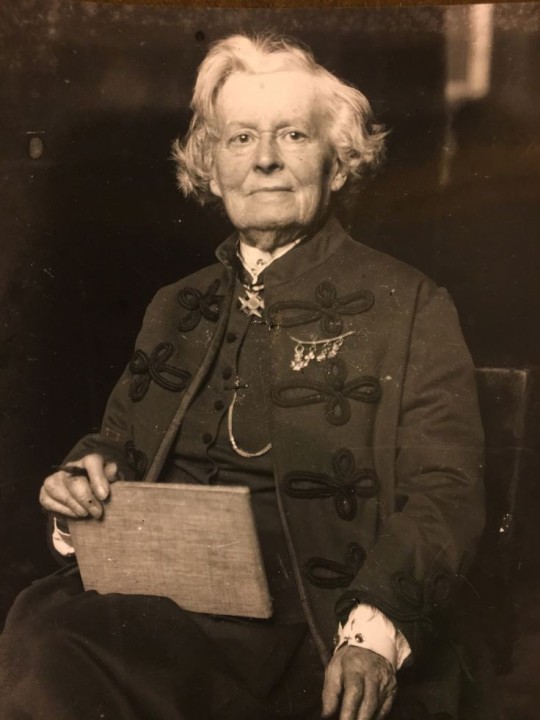
Marie-Rosalie Bonheur, known as Rosa Bonheur, was born in 1822 in Bordeaux and died in 1899 in Thomery. She was a French painter and sculptor specialising in representations of animals.
She has kind of an interesting family story (mother adopted by a rich guy who found out later who was her real father, siblings all artists, father who met a lot of interesting people, links with many famous people...) but it would be too long to talk about it and I want to focus on Rosa herself. Do check it up if you're interested!
During her youth, Rosa Bonheur had a reputation for being a tomboy, a reputation that followed her throughout her life and which she made no attempt to deny, wearing her hair short and later smoking cigarettes and cigars. Her emancipated lifestyle never caused a scandal, even though she lived in an era that was very concerned with convention. Like all women of her time, Rosa Bonheur had to apply to the Prefecture of Paris for a cross-dressing permit, renewable every six months, in order to wear trousers, in particular to attend livestock fairs, travel or ride horses.
Here's one of her permits, from 1857 :
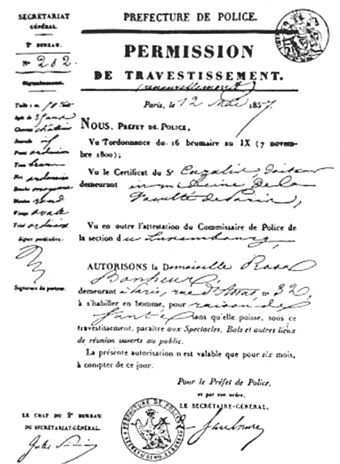
And though many historians tried to deny the fact that she was a lesbian, she always refused to marry a man, has only ever had relationships with women and literally wrote that she never felt any sort of love, attraction or tenderness for men, "besides a frank and good friendship for those who had all my esteem". After the death of the woman she loved, she also wrote "If I'd been a man, I'd have married her, and they wouldn't have made up all those silly stories..." You got it : even if she didn't shout it from the rooftops, Rosa was very probaby a homosexual woman.
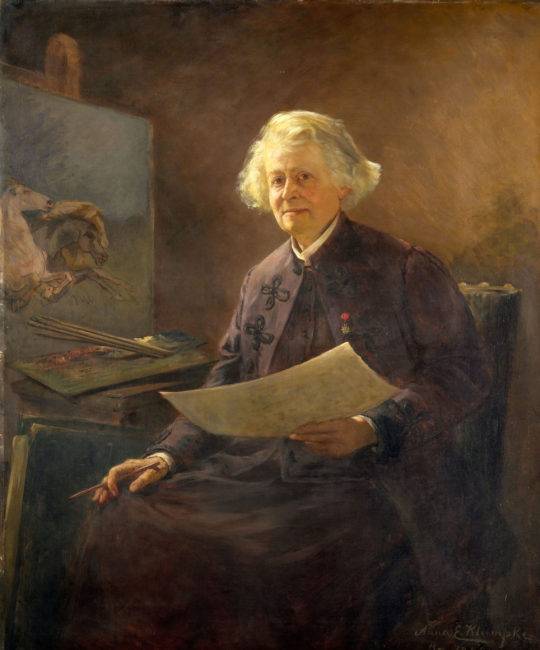
Rosa Bohneur grew up in a fairly wealthy family, thanks to the financial support of her mother's adoptive father. But when her mother's father died, the family was left without any such support, and fell into dire poverty. When Rosa was 11, her mother died, which deeply traumatised her. She kept a lifelong admiration for her mother.
In 1836, at the age of 14, she met Nathalie Micas, who became her lover. Only Nathalie's death 53 years later separated them.
Her father remarried in 1842 to Marguerite Peyrol, with whom he had a last son, Germain, who would also become a painter. Rosa Bonheur did not get on well with her stepmother and when her father died in 1849, she left the family home to live with the Micas.
After her mother's death, Rosa Bonheur went to primary schools, was apprenticed as a dressmaker and then went to boarding school. Eventually her father took her into his workshop, where her artistic talents were revealed. He was her one and only teacher. Gradually, she developed a passion for animal art, which became her speciality.
She exhibited for the first time, at the age of 19, at the Salon of 1841. She won a 3rd class medal at the Salon of 1845, and a 1st class medal (gold) at the Salon of 1848. This award enabled her, at the age of 26, to obtain a commission from the State to produce an agrarian painting (paid 3,000 francs). The painting resulting from this state commission, "Labourage nivernais" was supposed to go to the Musée des Beaux-Arts in Lyon. But it was so successful at the 1849 Salon that the Beaux-Arts department decided to keep it in Paris, at the Musée du Luxembourg. After Rosa Bonheur's death, the work went to the Louvre, before being transferred to the Musée d'Orsay in 1986.

When her father died in March 1849, Rosa Bonheur replaced him as director of the École impériale gratuite de dessin pour demoiselles (or École gratuite de dessin pour jeunes filles). She remained in this position until 1860: ‘Follow my advice and I'll turn you into Leonardo da Vinci in skirts’, she often told her pupils.
In 1860, she moved to a huge house in By, where she had a huge workshop built, and ample space for her animals. One of her relatives wrote: “She had a complete menagerie in her house: a lion and a lioness, a deer, a wild sheep, a gazelle, horses, etc. One of her pets was a young lion she let run around. My mind was freer when this leonine animal died".
In June 1864, Rosa was visited by Empress Eugenie, who invited her to lunch at the Château de Fontainebleau with her husband. The following year, Eugenie returned to see her, to present her with the Legion d'honneur herself. Rosa is the ninth woman and the first artist to receive this distinction. About this, The Empress said :
“At last, you've been knighted. I am delighted to be the godmother of the first woman artist to receive this high distinction. I wanted the last act of my regency to be devoted to showing that, in my eyes, genius has no sex."
She was also the first woman to be made an officer in this order, in April 1894 (first female officer of the Legion d'honneur).
Rosa traveled extensively with her lover Nathalie, herself a painter and mechanical enthusiast (she invented and patented a railway braking system), and painted many pictures inspired by her travels.
In 1889, Nathalie died after some 50 years together. It was then that Rosa expressed her regret at not having been able to marry her.
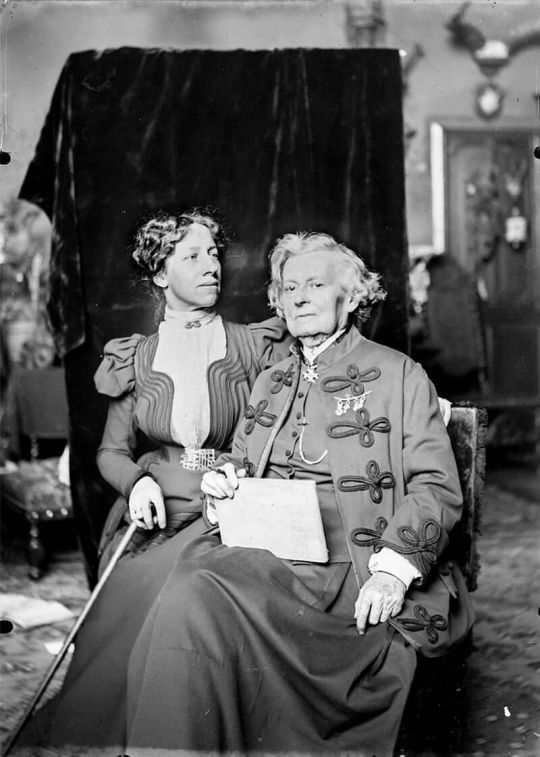
After Nathalie's death, Rosa met Anna Klumpe, a talented American painter. The two women moved in together some time later.
Rosa Bohneur died of pulmonary congestion in 1899, without having completed her last painting, “La foulaison du blé en Camargue”, a monumental canvas she had planned to exhibit at the 1900 Universal Exhibition.
She is buried in Père Lachaise cemetery, alongside Nathalie, her parents and Anna (who died years after her). She left her entire fortune to Anna, who, in 1908, published a biography of Rosa Bonheur and created a Rosa-Bonheur prize at the Société des artistes français. The Société des Artistes français posthumously awarded her the Medal of Honor shortly after her death.
Rosa could have had military honors at her funeral, but she specified in her will that she did not wish this.
There's a lot of interesting things to say about Rosa, her art and her history, so I suggest you do some research on her! She was a very talented and strong-willed woman who had a huge impact on French art and left a considerable cultural legacy.
Here are some of her paintings :




I personally love them ! I am not a painting expert, I just find them sooo pretty.
See you tomorrow :)
#lesbian#lesbian pride#pride#pride month#female homosexual#female homosexuality#rosa bonheur#french art#painting#art#lesbian history
231 notes
·
View notes
Text

1926 Elsie Behrens photographed by Alfred Cheney Johnston for Ziegfeld's Broadway show "No Foolin'". She was also in "Rio Rita", "Whoopee!", "Rosalie", "Louie the 14th" and "Smiles". Elsie was active on the stage until 1935 when she married businessman LeRoy Frank and retired. From Olden Snapshots, FB.
132 notes
·
View notes
Text
A Girl And Her Dog - A tribute/fuck you to "A Boy & His Dog," Viktor Blud is the telepathic despot of the Gravestone River, but that won't stop Rosalie and her dog Champion from going after him to take their revenge. Champ is more of a borzoi pangolin monstrosity than a dog but let's not get picky. The setting is a sort of post apocalyptic weird west on the planet where gods go to die. As seen in Lisa Frank Gulch.
Short Change Hero - Down on her luck two and a half foot ex-allotment farmer turned hopeful adventurer turned disillusioned bouncer / part time leg-breaker Obsidian Bonesplinter didn't want to rock the boat but when her old family shows up in the magical city Eliriad they get caught up in a bad way. Now she's got a dead body to explain and a murder to solve if she doesn't want the cops to pin it all on her and the only roommate she ever had with a steady job. A hardboiled noir mystery taking place in a fantasy world of magic and elves and fantastical creatures.
Saw Down Heaven - Follow up to Girl Bites God, a ragtag band of queers and superhumans try to drive police out of their local community and set up a patrol free zone outside of the reach of law enforcement and, worse, the FCC. With the help of the mutant ringworm colony and hole in reality which together animate the undead corpse of Alice Buzzsaw (aka the Suicide Gorgon) and escaped mental patient AthenA Six, maybe they can pull it off. Takes place in the disentangled world, a setting where our world is slowly being folded into a parallel reality where physical matter never existed.
128 notes
·
View notes
Text
Characters I Write For
Please message me with any ideas/requests! I need ideas(short fics or series)
Mostly write for fem!readers. I can write fluff, angst, smut, etc. If I’m not comfortable with something I can let you know
Character/Actor List
Favorite Characters/Actors To Write For
Draco Malfoy, Weasley twins
Jesse Pinkman
Paul Dano characters
Josh Hutcherson characters
Dean Winchester, Sam Winchester, Castiel
Damon Salvatore, Silas, Klaus Mikaelson, Kol Mikaelson
Rodrick Heffley
Bellamy Blake
Ezra Fitz(should probably make it clear I don’t condone)
Ian Duncan(Community)
Charlie(It’s Always Sunny)
Luke Castellan, Percy Jackson, Annabeth Chase
Finnick Odair
Tommy Shelby
Killian Hook
Paul Dano
Klitz(The Girl Next Door)
Dwayne Hoover(Little Miss Sunshine)
Edward Nashton(The Batman)
Calvin Weir-Fields(Ruby Sparks)
Brian Wilcox(Fast Food Nation)
Joby Taylor(For Ellen)
Nick Flynn(Being Flynn)
Josh Hutcherson
Peeta Mellark(The Hunger Games)
Mike Schmidt(FNAF)
Josh Futturman(Future Man)
Devon Bostick
Rodrick Heffley(Diary of a Wimpy Kid)
Jasper Jordan(The 100)
Cillian Murphy
Tommy Shelby(Peaky Blinders)
Dr. Jonathan Crane(The Dark Knight)
Neil(Watching the Detectives)
Christian Bale
Patrick Bateman(American Psycho)
Bruce Wayne(The Dark Knight)
Breaking Bad
Jesse Pinkman
Jane Margolis
Saul Goodman
Harry Potter(Golden Trio Era)
Harry Potter
Ron Weasley
Hermione Granger
Fred Weasley
George Weasley
Ginny Weasley
Luna Lovegood
Neville Longbottom
Draco Malfoy
Pansy Parkinson
Blaise Zabini
Theodore Nott
Daphne Greengrass
Adrian Pucey
Terence Higgs
Harry Potter(Marauders Era)
James Potter
Remus Lupin
Sirius Black
Lily Potter
Severus Snape
Regulus Black
Lucius Malfoy
Narcissa Malfoy
Bellatrix Lestrange
Arthur Weasley
Harry Potter(Fantastic Beasts Era)
Newt Scamander
Queenie Goldstein
Leta Lestrange
Percy Jackson
Percy Jackson
Annabeth Chase
Luke Castellan
Thalia Grace
Jason Grace
+ Gods
Criminal Minds
Spencer Reid
Aaron Hotchner
Emily Prentiss
Derek Morgan
JJ
Penelope Garcia
David Rossi
Elle Greenaway
Cat Adams
Megan Kane
Supernatural
Dean Winchester
Sam Winchester
John Winchester
Mary Winchester
Castiel
Charlie Bradbury
Rowena McLeod
Adam Milligan
Lucifer
Ruby
Jessica Moore
Gabriel
Benny Lafitte
Bela Talbot
Jo Harvelle
Ellen Harvelle
Superstore
Jonah Simms
Amy Sosa
Marcus White
Garrett McNeill
Dina Fox
Cheyenne Lee
Bo Thompson
Gilmore Girls
Lorelai Gilmore
Christopher Hayden
Luke Danes
Logan Huntzberger
Jess Mariano
The Hunger Games
Peeta Mellark
Katniss Everdeen
Gale Hawthorn
Finnick Odair
Johanna Mason
Haymitch Abernathy
Pretty Little Liars
Aria Montgomery
Spencer Hastings
Emily Fields
Hannah Marin
Mona Vanderwaal
Alison Di Laurentis
Jason Di Laurentis
Ezra Fitz
Toby Cavanaugh
Jenna Marshall
Caleb Rivers
The Vampire Diaries
Damon Salvatore
Stefan Salvatore
Katherine Pierce
Elena Gilbert
Jeremy Gilbert
Bonnie Bennett
Caroline Forbes
The Originals
Klaus Mikaelson
Elijah Mikaelson
Kol Mikaelson
Rebekah Mikaelson
Freya Mikaelson
Hayley Marshall
Marcel Gerard
Davina Claire
Twilight
Edward Cullen
Bella Swan
Alice Cullen
Jasper Hale
Rosalie Hale
Emmett Cullen
Victoria
The 100
Bellamy Blake
Octavia Blake
Jasper Jordan
Shameless
Fiona Gallagher
Lip Gallagher
Carl Gallagher
Frank Gallagher
Mandy Milkovich
Kevin Ball
Veronica Fisher
The Bear
Carmy Berzatto
Sydney Adamu
Richie Jerimovich
Suicide Squad
Harley Quinn
Rick Flag
Blackguard
Once Upon A Time
Emma Swan
Regina Mills
Killian Jones
Rumplestiltskin
Robin Hood
Ruby
Hades
Community
Jeff Winger
Abed Nadir
Annie Edison
Troy Barnes
Ian Duncan
It’s Always Sunny In Philadelphia
Charlie Kelly
Dennis Reynolds
Dee Reynolds
Mac
Cricket
House MD
Greg House
Robert Chase
James Wilson
Lisa Cuddy
Parks and Recreation
Ben Wyatt
April Ludgate
Andy Dwyer
MCU, Marvel
Steve Rogers
Tony Stark
Natasha Romanoff
Bruce Banner
Wanda Maximoff
Loki Laufeyson
Peter Parker(Holland, Garfield, Maguire)
Gamora
Peter Quill
Scott Lang
Steven Strange
Jessica Jones
Wade Wilson
DC CW
Oliver Queen
Barry Allen
Felicity Smoak
Laurel Lance
Sara Lance
Malcom Merlyn
John Constantine
Leonard Snart
Ray Palmer
Caitlyn Snow
Julian Albert
Rip Hunter
10 Things I Hate About You
Patrick Verona
Cameron James
New Girl
Jess Day
Nick Miller
Schmidt
Other Characters
Charlie Kelmeckis(Perks Of Being A Wallflower)
Jesse Eisenberg Characters
Dr. Who(10th Doctor)
Will Probably Add More
#draco malfoy#rodrick heffley#josh hutcherson#robert pattinson#cillian murphy#christian bale#paul dano#ezra fitz#marauders era#marauders#percy jackson#finnick odair#supernatural#damon salvatore#luke castellan#loki laufeyson#jesse pinkman#jesse eisenberg#peter parker#tasm peter parker#ian duncan#charlie kelly#jeff winger#logan huntzberger#logan lerman#killian jones#bellamy blake#carmy berzatto#fem!reader#jeremy allen white
53 notes
·
View notes
Text
The Amsterdam-based duo of Bolivian-born singer/instrumentalist Ibelisse Guardia Ferragutti and Chicago expat jazz drummer Frank Rosaly's MESTIZX debut US tour kicks off in two weeks, with shows in Kenosha, Minneapolis, Chicago, Philadelphia, and Brooklyn, and a set at Big Ears Festival in Knoxville. Details/tix here.
#ibelisse guardia ferragutti#frank rosaly#mestizx#live music#nonesuch#nonesuch records#international anthem
1 note
·
View note
Text
Ibelisse Guardia Ferragutti & Frank Rosaly — Mestizx (Nonesuch/Intl Anthem)

Two musicians with Latin roots but primarily Western musical training and experience dig into a multicultural heritage, incorporating indigenous rhythms, instruments and sounds into intricate space-age explorations of history, myth and personal authenticity.
The two musicians in question are Frank Rosaly, a well-regarded free jazz drummer whose exploits have been frequently chronicled here at Dusted. Jazz fans may associate him primarily with a thriving Chicago scene, but he has Puerto Rican heritage and now lives in Amsterdam. His wife Ibelisse Guardia Ferragutti is a singer and multimedia artist, classical trained but born in Bolivia. This is their first collaborative album, a careful excavation of the sounds and musical traditions of their respective Latin cultures, a reclamation, of sorts, of influences that neither artist feels fully able to claim as his or her own.
Authenticity, is, of course, a tricky concept. Ferragutti freely admits that growing up in Bolivia doesn’t necessarily entitle her to ownership of indigenous culture, while Rosaly, in the liners, admits to experiencing Puerto Rican culture largely as an outsider. Mestizx (a non-gendered term for people of mixed heritage) is as much about being estranged from one’s history as it is about participating in it.
So there is joy but also a sense of longing in these multi-rhythmed, intricatedly constructed cuts. The beats are insistent, celebratory, all-enveloping, and yet you glimpse them as through a window. Elements may come from isolated rainforest tribes—the two enlisted Fredy Velásquez a scholar and performance artist with expertise in Colombian indigenous rites as a collaborator—but they are viewed through the whole of the western tradition: jazz, rock and classical. The gorgeous “Saber do Mar” flickers like a hallucination, threads of drone winding through intricate structures of malleted percussion; it feels both real and imaginary, a place visited in febrile dreams.
These songs are sung mostly in Spanish, with occasional diversions into other dialects. The titles indicate political engagement (“Balada Para La Corporatocracia” translates as “ballad for corporatocracy,” “Destejer” as “to unravel.”) yet the music is anything but didactic. It seethes and undulates with an easy fluidity, Ferragutti’s serene vocals cresting over the synchronized clatter of percussive instruments made of metal, wood and skin. Other artists, mostly from Chicago, drop by to play. Ben LaMar Gay, Bill MacKay, Rob Frye, Mikel Patrick Avery and Avreeayl Ra all make appearances.
All of which coalesces in some genuine sonic pleasures. “Turbulência” barrels down a groove like a freight train, the shush and pop of samba rhythms clattering amid grinding bass and the trebly sparkle of keyboards. “Writing with Knots” pounds a two-toned cadence, shakers and fluttery melody at play, the thread of dissolution always looming. This one, in English, recounts the terrible history of colonialism, but also points towards the future. Like the Meztizx project writ large, It sends tendrils back into the past in order to plot a better way forward.
Jennifer Kelly
#Ibelisse Guardia Ferragutti#Frank Rosaly#mestizx#nonesuch#intl anthem#jennifer kelly#albumreview#dusted magazine#jazz#indigenous music#latin
1 note
·
View note
Text
Europe Jazz Media Chart - Marzec 2024
Wybór nowości muzycznych, które pojawiły się w bieżącym miesiącu, dokonany przez grupę czołowych europejskich magazynów i witryn jazzowych. A selection of the hot new music surfacing across the continent this month by the top European jazz magazines and websites. Miklós Lukács Cimbiosis Trio & Ligeti Ensemble Responses to Ligeti (BMC Records) Krzysztof Komorek, Donos kulturalny,…

View On WordPress
#Andy Moor#Anti#Aurom#Berthold Records#Blue Note Records#BMC Records#Brad Mehldau#Brian Blade#Bruno Parrinha#Charles Lloyd#Chris Potter#Clean Feed Records#Darius Jones#Dee Byrne#Edition Records#EJN Media Chart#Elephant9#Frank Rosaly#Fur#Giuseppe Doronzo#Gondwana Records#Hypnote Records#Jasmine Myra#João Gato#John Patitucci#Jūlija Zakirova#Ligeti Ensemble#Mark Lockheart#Michał Aftyka Quintet#Miklós Lukács
0 notes
Note
opinion on sheila?
i don't care for her. as a person. i've found her miscellaneous shenanigans a lot more enjoyable upon rewatch, though, since i'm no longer trying to find a way to still like her as a person. it's very sad for me to not like her because she is played by JOAN CUSACK whom i adore + naturally she fucking kills it in her performance. alas she is not dom top rosalie mullins from school of rock 😔
i contemplated leaving my response at that but i DO in fact think she's really interesting! i thought, you know, some other people have made Some posts about how she fucks up but tbh, come to think of it, usually they only go so far as to say "she did bad thing, therefore bad" and dont go past that! which is tragic. SO i'm going to. i hope.
please keep in mind as you read this that my biggest problem with sheila is her attempt to, as a white christian woman, adopt and raise a handful of native american children, which is a facet of cultural genocide (article II, item e) that the ICWA was literally created to prevent. i also dislike her for other reasons, but this is the biggest
sheila is probably the strongest example within shameless of a character being cute, charismatic, or "nice" on the surface, in a way that really powerfully distracts from the type of harm they're capable of.
particularly, in addition to being "nice" and carrying joan cusack's INCREDIBLE charisma, sheila is also disabled! she's terrified of a lot of things, and mocked by her husband for it. she absolutely deserves sympathy for her struggles with agoraphobia and a LOT of people conflate sympathizing with someone with having to accept their behavior. this is the flip-side of people not understanding that someone who has done something scary or messed up still has a sympathetic internal experience.
season one has sheila most of the time unable to enact harm because of her limiting circumstances. although she repeatedly ignores frank's sexual boundaries, he's also definitely taking advantage of her hospitality the entire time. frank often will lose sympathy points by acting horrifically in other ways, sheila's behavior will be ignored for how sympathetic she is. in season one, sheila also APPEARS to be a great and supportive mother to karen, specifically because of the contrast in how overtly judgemental and controlling eddie is. while watching this show with a friend of mine, she made the great observation that when sheila comes out of her shell a bit, you can really see how she wound up married to such a stuck up conservative asshole.
even so, sheila's inability to support her daughter hurts her. that's not to say she's at fault for the way her agoraphobia leaves karen feeling adrift, just that it happened. i really like season 1 sheila. karen also spends a lot of time feeling that it's her responsibility to take care of sheila, and while it's extremely nice of her to do, the fact is that sheila needed an adult's support, not her teenage daughter's. when karen spends so much time acting protective towards sheila, which sheila was undoubtedly both touched and embarrassed by, i think this also pushes forward into both of their minds the way that sheila views karen in some ways as more of a bestie/equal than a child under her care.
note also here - sheila seems to have no grown up friends! there are a couple times when she tries to branch out (christianmingle, selling sex toys) but they don't seem to work out. she even sort of alludes to knowing people at her old job at a hair salon, but she seems to never have actually be close to them, just sort of friendly. she is extremely lonely, probably since even before she developed agoraphobia.
sheila is loud and brash and strange, which masks in ways that she may also be very very insecure. it makes sense if she only bonds with little kids if she's terrified of the judgement of an adult. (this is also a problem with kash - though obviously, kash takes this in a worse direction by pursuing ian romantically). she's also GOOD with little kids. she absolutely is not good with teenagers. i would absolutely trust her to watch a toddler, i don't think there's any real problem with that.
however, please see: sheila playing with liam, she asks him "which do you prefer, the baby, or the whore?" this line is hilarious. it also points to her having more or less the same conservative view of sexuality that results in karen's DaddyzGirl plotline. it feels relevant she uses a blonde barbie to represent the "whore".
sheila also seems more involved in catholicism than the gallagher family. to be sure, the gallaghers are catholic, but i didn't get the impression that it was as much of a religious identity to them as something they just inherited and went with.
by the time jody shows up in karen's plotline, sheila is established so aggressively as being kooky and unable to handle a lot of the "real world", that when i recall thinking, oh, well, she shouldn't be letting this guy around her daughter, but i'm not sure she understands whats happening. and it's true she probably didn't. part and parcel to her viewing karen as more of a best friend than a child in here care, and her inability to understand teenagers the way she does littler kids - she just defaults to trying to interact with karen as another adult.
sheila being more catholic also adds an interesting layer to how much she wants karen to go out with jody, given that karen is a bisexual girl, even if sheila might not be aware of that.
i assume we're already in agreement that she shouldn't have allowed karen to marry a 37 year old - which she definitely had to consent to. in an interesting parallel here with my general read of mickey being the karen to ian's lip, the united states does allow people under 18 to get married, but only with a parent's consent. mickey is the only other character i can think of whose parent gives such horrifying and enthusiastic consent to their marriage (and, similarly - both lip and ian show up to these weddings, get drunk, and make an ass of themselves)
sheila viewing karen as a best friend more so than a daughter also is what leads her to believe it's acceptable, just kind of bitchy, to sleep with jody. jody is another incredibly immature adult. this is a running and well executed theme in most of the predatory characters on this show. karen didn't want him, and sheila later apologizes for all the wrong reasons.
sheila obviously gets hit with another massive wave of loneliness and regret after she kicks her daughter out - she doesn't seem to understand that attempting to force someone to keep an unwanted pregnancy or child is a surefire way to ruin a relationship, and almost certainly thought that karen would go into playing this "sweet little girl" role she expects of having a cute, blonde, daughter. this also shows up in sheila's idealization of karen's relationship to jody. sheila can't accept that karen is outspoken and independent, she wants karen to be a housewife and a princess - karen apparently loved princess stories as a small child (or sheila thought she did), and sheila is unable to accept that that's changed - and she wants jody to be the prince in this story.
even when karen comes back, sheila still can't wrap her head around karen not being obligated to be a mother. she's horrified to learn that karen had told hymie's father's family that sheila "wasn't safe", when karen just wanted desperately to go back to before, because she wanted her mom to love her, and she wanted to feel close, without the imposition of an unwanted child from a traumatic pregnancy.
this might be a reflection of the disaster that was sheila's marriage - a lot of women will try to make up for what they feel they missed out on by projecting onto their daughters' lives. sometimes this is just awkward, but sheila decides to send her brain damaged, absolutely unable to consent, daughter off with jody. when karen becomes disabled sheila sees her no longer as a best friend, but more like a doll. come to think of it, this might be why she got so enthusiastically involved in ..."activism"... for down syndrome. it's an exciting role to play for her.
jody makes probably one single good point in his entire life, which is that hymie should stay connected to his chinese heritage. he obviously didn't care THAT much, and sheila wasn't really listening, because these two later separate hymie from family who DO want him (tommy and his mother) to participate in this fanciful idea.
sheila is, after that, somehow surprised to learn she feels lonely again! she desperately seeks out community however she can - this time in latching onto being 1/32nd menominee after taking a DNA test (as per my memory?) - there's not really anything wrong with wanting to know more about a part of your heritage, and if she'd been more normal about this, who would've fucking cared?
carl doing a crappy imitation of black culture while he believes himself to be 1/8th black is the closest comparison here. sure, sheila also might've really identified as native at that point, maybe she meant well! however, sheila is a grown adult, who tries to build this connection through children. carl, is, however fourteen years old, and he tries to get involved in black culture by hanging out with and emulating older people, befriending and protecting nick, and failing pretty embarrassingly at getting a date. even so, carl's behavior is cringeworthy enough to get commented on by pretty much everyone in the show.
and sheila's attempts to adopt these random children are the culmination of her "cute little baby" obsession - it doesn't escape my notice that she barely pays attention to the oldest (gary?) and focuses heavily on a little girl - and her desperation to find community. she again ignores frank's right to consent or not (and.. the legality of bigamy) to marry frank solely to acquire cute little kids, and, by her hope, a connection and real reason to be involved in a tight knit community.
one of the points at which joan cusacks acting really sticks out to me is when she's at the hearing in hopes of approval for her adoption, and she's sort of playing hard at being "in" group - to boost her chances at getting approved adoption, and because she really, really wants to be "in". she kind of believes she's getting there until the council start to talk to each other in menominee which she, of course, has no clue at the beginning of how to understand. they're just speaking in their own language, but she feels an acute sense of exclusion. when they conclude and simply say "no"- no explanation offered, because why bother to explain to someone who is not going to get it - she has this devastation on her face, because she realizes she was not going to be "in" anyway, no matter what.
when it comes to these kids, yeah, they may have wanted to live with her. but they're kids! they like wifi, and cool snacks, and tv. children deserve a lot more respect and to be trusted, but they also can't understand why it'd be harmful to grow up in a white christian household.
sheila reattaches herself to frank pretty aggressively in response to her new, new, new, old loneliness. she again views someone's daughter as a peer (or adversary) and not a daughter - though with sammi, at least she's a grownup with boundary issues.
sheila's writing is less compelling to me after this, but that might just be because when she really really does try to adopt these kids, i kind of blacked out from rage, and couldn't stand to really look at her. in my rewatch i might pick up on more in s5. she does get pretty involved in the gentrification plotline, though, which is well written, but super difficult for me to look at directly (high fives for anyone who will never afford a house in their hometown) i really hope that her independent sheila life will give her some self confidence by herself, so she'll feel better AND stop twisting herself into these convoluted choices and taking really bizarre kinds of advantage of people in an effort to find ANY community. but idk maybe she'll become a scientologist or something. who really knows
#Anonymous#'hey arent you the guy who writes a really long post about literally everything why does THIS one get a readmore' dude trust me#hope you werent waiting with too bated of breath for this#it got postpned by my scheduled rewatch of terminator 2. which takes precedence over literally everything. you know.
15 notes
·
View notes
Text
Ranking best fictional characters (I only include ones I seriously like)
Hunger Games: 1. Finnick Odair (duh) 2. Katniss Everdeen 3. Peeta Mellark
Harry Potter: 1. Weasley Twins (they're a set) 2. Harry Potter 3. Luna Lovegood 4. Hermione Granger Honorable mention to Snape.
Percy Jackson: 1. Percy Jackson (is that even a question?) 2. Leo Valdez (duh) 3. Annabeth Chase 4. Jason Grace. 5. Frank Zhang 6. Hazel Levesque Honorable mention to Apollo! Kane Chronicles: 1. Zia Rashid 2. Carter Kane 3. Sadie Kane Magnus Chase: tbh I don't remember any of the characters it has been too long. I liked Magnus tho. Twilight: 1. Emmett Cullen 2. Rosalie Hale 3. Bella Swan (but ONLY in book 3) Shatter Me: DNF (I could not get behind Warner, sorry!), but Kenji was elite. Divergent: 1. Will 2. Four 3. Tris I will never NOT be mad that Tris died but Caleb fucking survived. The Maze Runner: I remember very little of this series, but I miss Teresa :(( Vampire Diaries: This is the one with the Salvatores, right? Yeah, DNF. I hated Damon from the start and I could never get behind him, sorry. The Selection: 1. Maxon Schreave 2. America Singer 3. Celeste Newsome 4. Marlee Tames Honorable mention to Amberly :)) Red Queen: 1. Mare Barrow 2. Shade Barrow 3. Cal Calore 4. Evangeline Samos Honorable mention to Farley and Kilorn Warren Throne of Glass: 1. Lorcan Salvaterre 2. Chaol Westfall 3. Yrene Towers 4. Elide Lochan 5. Dorian Havilliard Honorable mention to Papa Gavriel and Fenrys, we didn't get enough of them A Court of Thorns and Roses: 1. Lucien Vanserra 2. Eris Vanserra 3. Nesta Archeron Honorable mention to future Elain, former Tamlin, and Tarquin Crescent City: 1. Ruhn Danaan 2. Lehebah 3. Lidia Cervos 4. Tristan Flynn 5. Ithan Holstrom Honorable mention to the remaining frat boys + Hunt TV SHOWS: Pretty Little Liars: 1. Emily Fields 2. Jason Dilaurentis (I can't be the only one who wanted him and Aria to end up together, am I?) 3. Hana Marin Gossip Girl: 1. Nate Archibald (Serena, you fucked up) 2. Blair + Chuck (they're a set) Do we have the same taste? Let me know how many of these you agree or disagree with!
#finnick odair#weasley twins#percy jackson#zia rashid#magnus chase#emmett cullen#kenji kishimoto#will divergent#teresa maze runner#maxon schreave#mare barrow#lorcan salvaterre#lucien vanserra#ruhn danaan#nate archibald#emily fields
53 notes
·
View notes
Note
I HAVE AN AU IDEA INSPIRED BY YOUR LAB RATS AU BUT ITS A COMBINATION OF BURNER AND ITS TIME FOR THE!!!
I haven't drawn it yet, but here's the concept:
The Keeping Inhumans Safe in the Sanctuary (K.I.S.S for short) has a plethora of interesting individuals with supernatural abilities:
Phillip (Pilly) ((Super Intelligence/Mind Control)) 26
Leonard (Limey) ((Half-Lizard)) 17
Kate (Kit) ((Psychokinesis)) 16
Pablo (Polaroid) ((Imagination)) 28
Sabrina (Spraypaint) ((Liquid Control)) 16
Rosalie (Rose) ((Plant Growth)) 20
Peter (Peanut) ((Earth Manipulation)) 23
Hannah (Hanger) ((Elasticity)) 13
Pierre (Playdoh) ((Teleportation)) 18
Eli (Erasey) ((Omniscience)) 15
Tucker (Tissues) ((Time Manipulation)) 50
Rebecca (Record) ((Sonic Scream)) 20
Shinji (The Sun) ((Pyrokinesis/Flight)) 4
Frank (57 Ball) ((Invisibility)) 30
Ryan (Refill Station) ((Hydrokinesis)) 16
Felix (Felt Container) ((Necromancy)) 18
Walker (Wheel) ((Super Strength)) 17
Paisley (Polka Dot) ((Portals)) 16
Vanessa (Vase) ((Floral Manipulation)) 26
Nolan Wayne (No Way) ((Cloning)) 18
Warren (WWFT) ((Shapeshifting)) *Into every animal. 17
Would you like me to tell you more about the AU?
Woah that's a lot of characters lol
Interesting though I would indeed like to know more lore :D
17 notes
·
View notes
Note
[Voicemail from an unknown number]
[Voicemail transcript start]
[ROSALIE: Hey, Uh, so like. I know you hated me or whatever cause I was pathetic or something? I dunno what your reasoning was. ANYWAY! I- [pause] to be frank I kinda hated you too. I stuck around cause if I left you'd kill me, and then you killed me anyway for something that literally wasn't even my fault. what the hell! ..[sigh] whatever. [long pause] I don't- [short pause] I wish I knew why you kept me around, at all.]
[End Voicemail Transcript
Hemic: Lmao like I care
She deletes the voicemail.
3 notes
·
View notes